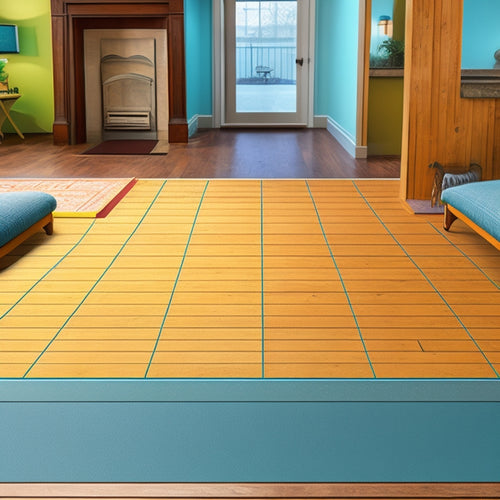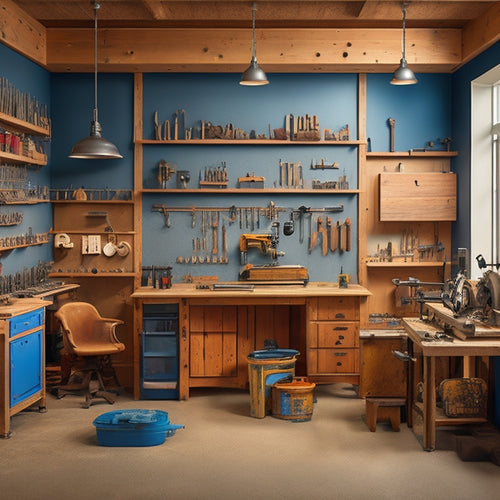
3 Best Tools for DIY Concrete Floor Renovation
Share
You'll need the right tools to achieve a professional-grade finish in your DIY concrete floor renovation project. Start with a heavy-duty concrete floor grinder, which efficiently removes old coatings and smooths surfaces. Next, invest in efficient edging and polishing tools, such as walk-behind or handheld edgers and variable-speed polishers, to achieve a flawless, high-gloss finish. Finally, must-have concrete finishing equipment like a high-quality concrete mixer, surface preparation tools, and concrete floor scrapers will help you meet project timelines and client expectations. By equipping yourself with these essential tools, you'll be well on your way to a successful concrete floor renovation.
Key Takeaways
• Invest in a heavy-duty concrete floor grinder, such as a walk-behind or handheld model, for efficient surface preparation.
• Use a high-quality edger, like a walk-behind or handheld model, for precise control and maneuverability around baseboards and corners.
• A variable-speed polisher with diamond-coated or resin-bonded pads is essential for achieving a high-gloss finish on concrete floors.
• Remove old adhesives, paint, or substances with a concrete floor scraper or edger for a smooth, even surface.
• Wear personal protective equipment (PPE), including a dust mask, safety glasses, and ear protection, to ensure a safe DIY concrete floor renovation.
Essential Concrete Floor Grinders
You'll need a concrete floor grinder that's designed for heavy-duty use, one that can efficiently remove old coatings, smooth out rough surfaces, and prepare your floor for finishing.
There are several concrete grinder types to choose from, including walk-behind, ride-on, and handheld models. Each type has its own unique benefits and is suited for specific tasks and floor sizes. Walk-behind grinders are ideal for large areas, while ride-on models offer increased productivity and reduced fatigue. Handheld grinders are perfect for smaller areas and tight spaces.
When operating a concrete grinder, it's essential to take necessary safety precautions to avoid accidents and injuries. Always wear personal protective equipment (PPE), including a dust mask, safety glasses, and ear protection.
Verify the grinder is properly maintained and regularly serviced to prevent mechanical failures. Additionally, keep the work area clean and clear of debris to prevent tripping hazards.
Efficient Edging and Polishing Tools
When it comes to achieving a flawless, high-gloss finish, efficient edging and polishing tools are essential for honing in on tight spaces and refining your concrete floor's overall appearance.
You'll need to master advanced edging techniques to tackle areas like baseboards, corners, and edges. Invest in a high-quality edger, such as a walk-behind edger or a handheld edger, designed for precise control and maneuverability.
For polishing, you'll require a range of polishing methods, including chemical-based and mechanical polishing. A variable-speed polisher will allow you to adjust the speed to suit the specific polishing stage and concrete type.
Don't forget to pair it with the right polishing pads, such as diamond-coated or resin-bonded pads, to achieve the desired level of shine. With these tools, you'll be able to achieve a showroom-quality finish that's both durable and aesthetically pleasing.
Remember to always follow the manufacturer's instructions and take necessary safety precautions when working with these powerful tools.
Must-Have Concrete Finishing Equipment
With a focus on delivering a professional-grade finish, having the right concrete finishing equipment at your disposal is essential for meeting project timelines and exceeding client expectations.
You'll need a range of specialized tools to achieve a smooth, even surface. First, invest in a high-quality concrete mixer to guarantee consistent, well-blended batches. This will save you time and effort in the long run by reducing the likelihood of defects and imperfections.
Next, turn your attention to surface preparation. A walk-behind power trowel or ride-on power trowel will help you achieve a uniform, smooth finish. These machines are designed to handle large areas efficiently, making them ideal for commercial or residential projects.
Additionally, consider investing in a concrete floor scraper or edger to remove old adhesives, paint, or other substances that may be interfering with your new finish.
Frequently Asked Questions
How Do I Prepare My Subfloor Before Applying a Concrete Overlay?
Before applying a concrete overlay, you'll need to prepare your subfloor.
Start with a thorough subfloor assessment to identify any cracks, unevenness, or damage.
Clean the surface meticulously, removing dirt, oil, and old adhesives.
Use a degreaser and pressure washer to guarantee a spotless surface.
Then, fill any gaps or cracks with a patching compound and allow it to dry completely.
This guarantees a strong bond between the old subfloor and the new overlay.
What Safety Precautions Should I Take When Working With Concrete Dust?
When working with concrete, you'll generate a lot of dust, so it's crucial to take safety precautions seriously.
You should always wear a dust mask rated for concrete dust to prevent respiratory issues.
Don't forget eye protection, like goggles or safety glasses, to shield your eyes from flying particles.
This gear will be your first line of defense against the hazardous effects of concrete dust, so don't skip it!
Can I Renovate a Concrete Floor With Cracks and Unevenness?
You're wondering if you can renovate a concrete floor with cracks and unevenness. The answer is yes, but you'll need to tackle those issues first.
Start by addressing cracks with a crack repair compound, following the manufacturer's instructions.
Next, focus on surface leveling, using a self-leveling compound to achieve a smooth, even surface.
With these steps complete, you'll have a solid foundation for your renovation, and you'll be ready to move forward with confidence.
How Long Does It Take for a Concrete Floor to Fully Cure?
You're wise to wonder how long it takes for a concrete floor to fully cure.
The curing process is essential, and it's affected by moisture levels. Generally, it takes 28 days for concrete to reach its full strength, but it can take up to 6 months for it to fully mature.
During this time, you'll need to maintain ideal moisture levels, usually between 50% and 80% relative humidity, to guarantee proper hydration and strength development.
Are Concrete Floor Renovations a Good DIY Project for Beginners?
You're wondering if concrete floor renovations are a good DIY project for beginners.
On one hand, it's a great way to save money and gain hands-on experience.
On the other hand, it requires specialized tools and materials, and mistakes can be costly.
Weigh the pros and cons carefully: do you have the skills to handle the physical demands and complex processes?
If so, you'll need to invest in the right tools and materials to guarantee a successful outcome.
Conclusion
As you stand back to admire your newly renovated concrete floor, remember that the tools you've chosen are the keys that release its true potential.
Just as a master painter selects the perfect brush to bring their vision to life, you've carefully curated the right tools to transform your space.
With these three essential tools by your side, your concrete floor is no longer just a foundation, but a work of art that tells a story of dedication and craftsmanship.
Related Posts
-

7 Crucial Tools for a Successful Stucco Renovation
To guarantee a successful stucco renovation, you'll need a range of essential tools. First, invest in a stucco mixer ...
-

5-Step Subfloor Prep Checklist for a Smooth Renovation
You can guarantee a smooth renovation by following a 5-step subfloor prep checklist. First, assess the current subflo...
-

Renovation Tool Checklist for Smooth Finishes
When tackling a renovation project that requires a smooth finish, you'll need a thorough tool checklist to guarantee ...


